Product Requirements:
Desktop:
Windows 98, NT 4.0, Windows ME, Windows 2000, or Windows XP
Judie’s comments in BLACK
Julie’s Comments in BLUE
There are a couple of features that we as the PDA buying community have
learned to expect when we purchase a new device. Then there are those features that can
differentiate between a good device and a "dream machine."
For the Palm sector, a good device would probably include: 8MB of RAM,
a color screen and a memory expansion card slot of some kind. A dream
machine might have: 16MB RAM, a 16K high resolution screen, a memory slot of some
kind, a built-in camera, multi-media capability, and a soft
graffiti area. (Hmmm, sounds like I am describing the new
CLIÉ NR70V,
doesn’t it?)
Is that why we BOTH pre-ordered them? :o)
In the Pocket PC community, a good device would include: 32MB RAM, 16MB ROM, a
16K high resolution screen, multi-media capability, and a built-in Compact Flash
(CF) or Secure Digital (SD) expansion slot. A dream machine might include:
a minimum of 64MB RAM, 32MB ROM, a 16K high resolution screen, multi-media
capability, two built-in expansion slots, and a small form factor
– preferably with a built-in screen cover. Of course, adding "always on"
CDMA wireless capability without compromising battery life would truly bring such a device to
"dream machine" status – at least for me, but I digress…
My dream machine would be the Toshiba e570 with the
battery life of my old Palm III, 128mb of RAM, 8mb of non-volatile RAM, built-in
Blackberry / i705 wireless features and a flip lid. :o)
Okay, if we are going to go there: Right now my dream machine would be
the new Clie NR70V…running Pocket PC 2002! But what are the chances of that
happening?;0)
While the Hewlett Packard Jornada 560 series actually comes quite close to
fulfilling many of the basic points on my "dream machine" list, there is one
area in which it falls slightly short: a second built-in expansion slot. Similarly, there are
many ways that the Compaq iPAQ 3800 series could have been a contender – but for
the lack of a second built-in expansion slot and an integrated screen cover. Manufacturers of both of these
devices have certainly come out with expansion solutions for their respective Pocket PC
models, but
the fact of the matter is that by adding their versions of expansion that
utilize "sleds" or "sleeves,"
you will also add to the original device what can amount to substantial weight
and bulk.
I agree… and that’s the one reason why I’ve never
been completely in love with the iPAQ. Besides increasing the size of the
device, if you use a sleeve, you need a different case to carry the PDA in than
when you just use it without a sleeve.
Casio hit a home-run with me, as many of you will recall, when they
released their latest Pocket PC, the E-200. Sporting all of the requirements on my list
(except for the built in screen protection), the E-200 seemed like a true
solution for those of us that can’t leave home without two memory cards – or a
memory card and some other after-market add-on that fits in either the SD or CF slot.
Julie and I were pleased when we were offered the choice by Microsoft of
receiving either a
Compaq
iPAQ 3870 or a
Toshiba e570 Pocket PC. As many of you know, we personally purchase the
majority of the PDAs that we review here at The Gadgeteer. Since these purchases
come out of our own pockets, we often have to make the tough decision of which
PDAs we will be able to review or not, based on which ones we are willing to
buy. Since we had both already purchased
iPAQ 3835/3850s last year, and Bluetooth was the only difference between
those models and the new 3870, we each decided to ask for the e570.
Right, I wanted the Toshiba because it was something
new and different than what I had used before. That said, I pretty much hated
the style when I first saw it at Mobius 2001.
Exactly! But then, you have to remember that we barely got to handle it –
since every other person was crowded around trying to play with it, too! Plus it
had the Japanese OS, so it wasn’t like we could do that much with it. ;0)
For those of you that may or may not be aware of it, the Toshiba e570 is
essentially the same exact PDA as the
Audiovox Maestro. The main differences between the two devices are the
obvious company branding and the additional 32MB RAM that the e570 has over the
Maestro. The Maestro is marketed as a consumer device, and you can purchase one
on the web or in various brick and mortar stores. For whatever reason, the e570
is aimed solely at the corporate enterprise market. In fact, the only way that I
am aware of to purchase
one is to call Toshiba directly. Needless to say, the 64MB e570 is
definitely the version I would have chosen were I making the purchase for myself…
and why a Pocket PC manufacturer wouldn’t think that everyone, consumer and
corporate buyers alike, would like that choice is beyond me.
I don’t understand the way Toshiba has chosen to do
things either! The e570 could be a really popular PPC if it was available in
retail outlets. As it is, people have to ‘work’ at buying one. <scratching my
head on that one>
Before I received the Toshiba e570 earlier this month, I was
very happy with the Casio E-200. I figured that it would continue to be my "Daily Driver"
for some time…well, at least until the new X-Scale processor devices begin to
appear later this year. However, within 15 minutes of opening the e570’s box, I
realized that I was becoming infatuated with the muted silver styling of the
Toshiba, verses the flashier personality of the E-200. Since the temptation bug
would have never bitten me if the E-200 and the e570 weren’t so similar in their
hardware features, this review will contain a lot of comparisons between the two
PDAs.
Before I received mine, I was on a
‘vacation’ from my PPCs and using the Sony CLIÉ
T615C as my main brain. I was all set to stay in the Palm OS camp too, but
it didn’t take long for me to feel a tug back into Pocket PC land when the
Toshiba arrived. The dual memory slots and size did it for me.
Because no PDA relationship should be based solely on the lure of good looks and
a slightly smaller overall body size; I resolved to really get to know the
e570 in an effort to determine if this might really
be the right PDA for me, at least for right now.
Hardware Specifications
These are the e570’s specifications, according to the Toshiba Website. Any differences I
found are noted in red, as are my comments:
Processor: Intel StrongArm, 206MHz (1.75V)
Main Memory: 64MB on board SDRAM
Program Memory: 32MB CMOS Flash ROM
Display: 3.5" A-Si TFT Reflective Color, 240 x 320 (portrait) resolution
(16bit), Fluorescent lamp front light, Internal display supports up to 64K
colors
The display actually measures 2.9" (7.3cm) tall x 2.2"
(5.7cm) wide.
Touch Panel: Analog resistance sensitive system touch panel
Buttons: 5-way navigation button, 4
(re-mappable) application buttons, and a voice
record button (also re-mappable).
Expandability: 1 Type II CF card slot (3.3V), 1 SD card slot (3.3V)
Ports: Cradle connection port, stereo headphone jack, infrared port (115kbps)
Sound: Philips UDA 1341TS Sound Chip, 13 bit stereo, 44.1kHz sampling rate, Full
Duplex support, adjustable sound volume (by software), built-in speaker and
microphone, stereo headphone port
Dimensions: 3.0" wide x 4.9" tall x 0.07" thick
Weight: 6.3oz (My e570 weighs 6.5 oz (184g) with no
expansion cards or stylus installed)
Battery Pack: Rechargeable Li-Ion battery, 3.7V x 1000mAh capacity
Operating System: Microsoft Pocket PC 2002
Warranty: 1 year parts and labor, 1 year battery
Included in the box: One (extremely flimsy)
stylus, a USB cradle, an AC adapter (w/power cable) and a soft
(supposedly) leather slipcover
(but it feels and smells like cheesy plastic!), MS
CD-ROM, and a Quick Start Guide.
My first impression of the e570 was how tiny and slightly "CLIÉ-like"
it seemed to be. When I picked it up, I liked its weight, and the way it felt in
my hand. The matte silver and grey body looked professional and slightly
understated. I liked the blue rubberized side rails, in fact, I think they lent
to the CLIÉ "feel" of the device. This is not a flashy Pocket PC like the E-200
or even the iPAQ 3800; although I do think it is just a little bit showier
than the HP 560.
My first thoughts about the Toshiba were that it seemed
more business like… more "matter of fact". It definitely looks more professional
than the HP and the Casio and not as futuristic as the iPAQ. Although I didn’t
care for the style at all, when I first saw the unit months before; actually having one in
my hand for a few minutes was all it took for me to fall for it.
I really like the physical size of this Pocket PC. I’m
pretty sure that it the most compact PPC 2002 device so far that has both a CF
and SD slot built-in. I have only played with Judie’s Casio E200 briefly, but I
think the Toshiba might even be a little smaller.
Actually, it is. And we will get into size comparisons in just a little
bit…
I like the e570’s weight, its size, and its shape. It
feels good in my hand and is comfortable to hold and use.
Yes, next to the HP 565, the Toshiba is my pick for the Pocket PC that just
feels good to hold. This unit is solid and when squeezed from any
direction gives no disconcerting groans, so it easily passes Julie’s creak test.
I should mention that since I am not usually one to actually read the
instructions, much less the "Quick Start" guide that accompanies any new PDA, I
was thrown for a loop when I first tried to turn my Toshiba on. It appeared as
if my unit was dead, and just as I was about to refer to the guide in
frustration (horrors!), I saw the little sliding Battery Switch on the bottom.
Just as on the iPAQ 3600 series, this switch will also perform a hard-reset when
pushed to the right.
Unlike the iPAQ, there is also a Battery Switch lock that will keep you from
accidentally doing this. I’ll talk more about this feature later…
Heeheehee! Judie, I did the same thing! I thought mine
was DOA and started getting really disappointed. But unlike you, I did open the
Quick Start guide. Panic will do that to you, even if you are a Gadgeteer!
<blush>
| The e570 has a button layout that will seem slightly familiar to those that are used to the iPAQ’s, in that there are two application buttons on either side of a somewhat centered directional pad. The Toshiba’s joy-pad is listed as being 5-way (right, left, up, down, and hold/select), and as such it may hinder some serious gamers. The good news is that there are no multiple button press issues like the iPAQ 3100/3600/3700 series had. This button layout is also reminiscent of every Palm device’s, and it is The joy-pad is the best It is also curved slightly inward, like a bowl, so that your thumb or |
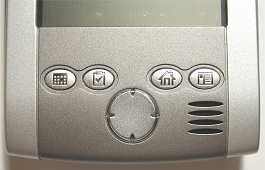 |
Because I have been happily using the E-200 for several months, and even
chose to use the HP 565 over the iPAQ 3800 when my Casio’s backlight failed, I
think I can finally say that I have conquered my iPAQ bias. That stated, the
e570 is the first Pocket PC that I have felt was as visually appealing as the
iPAQ to my personal taste. One of the things that makes the Toshiba even more
attractive is the fact that you can customize it with the addition of
interchangeable side rails. Seriously. In an attempt to make the e570 more
personalized, Toshiba has released a four-pack of colorized side rails, in
black, teal, maroon, what can best be described as "puke yellow."
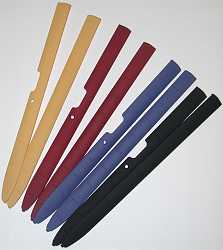 |
I also like the interchangeable side rails. Although the colors that are available aren’t the most pleasing (who picked the mustard color?!), it’s still a cool idea. What I’d like to see is brushed metal rails or even polished wood rails… I mean, why not?! ;o) I think wood or metal rails would be an excellent touch, although I suppose You could still have ridges cut into the rails… Since the Casio E-200 and the Toshiba e570 are the most similar of the |
| As you can see, the Toshiba is slightly shorter than the Casio. It is also a bit narrower, but it is of the same thickness. This is
|
From top to bottom: the Toshiba e570 and the Casio E-200 |
||||||||||||
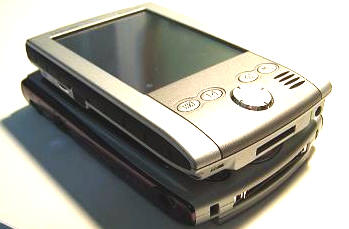
From right to left: Toshiba e570 and Casio E-200 |
The Toshiba and the Casio have the exact same size The screen is small like the HP 565. I think Toshiba might use the same screen because like the HP, it has a slight warm If I understand correctly though, the smaller screens on the Toshiba and I think you’re right… but for me, I like the
|
||||||||||||
| Here you can better see the two PDAs stacked on top of each other, and their similar thicknesses. |
|
||||||||||||
|
From left to right: Casio |
…and finally, a comparison between the Toshiba and Casio’s weights shows that they weigh exactly the same emptied of all styli, CF and SD cards.
It is interesting that the Toshiba occupies slightly less space than the |
Now that you have the comparisons of the two most similar Pocket PC 2002
devices, it is time to take a look at what makes the Toshiba unique in the
Hardware department.
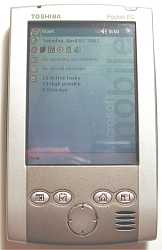
|
The Toshiba’s power button is located on the upper right edge of the PDA. As a former Palm V user, I like this position as it is familiar to me – even after all this time. I’ve had a You know what, though? This isn’t just a Toshiba issue. I have noticed I never had that much trouble with my 3835, but I There is a charge indicator light on the upper left edge. While the e570 The LED will also blink amber when an alarm goes There are four programmable buttons arranged two-by-two around the joy-pad. The speaker sits directly to the right of the joy-pad, or "cursor/navigation MP3 playback through the e570’s speaker is decent, although using a set To determine which PPC out of the 3670 iPAQ, 3835 For MP3 listening, I listened to the same songs at |
| I am not sure whether the button layout of the e570 will be a problem for gamers or not. Personally, it seemed fine to me for the logic-type games I like to play. I found it perfectly comfortable even for some |
 |
| The back of the e570 is quite plain, as there are none of the removable batteries like you will find on the Casio. For some, this My only concern with the Toshiba is that the battery is only Ditto on that remark. I think Toshiba dropped the I think that while the Toshiba actually gets quite decent battery life, The two little nubs that you see near the bottom of the e570’s back are |
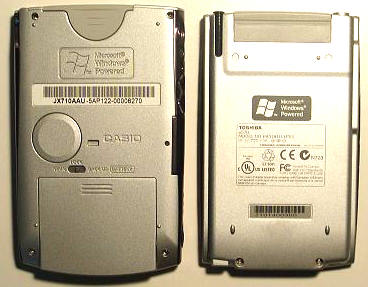 From right to left: Casio E-200 and the Toshiba e570 |
 |
The top of the e570 contains the headphone jack, SD/CF slots, and the stylus silo. The SD/CF slot cover located on the top of the With that in mind, I conducted a highly unscientific stress test and I do not like the plastic CF/SD card cover at all. |
| When you open the SD/CF door, you expose the stacked SD and CF card slots. This configuration is perfect for me, as I use two memory cards everyday. I understand that some will say that the top of the You’ll notice that there is a notch cut into the plastic cover that I Okay, well then |
|

The left side of the e570 is where you will find the
Microphone, Record button, the Infrared port, and the Reset button.
As I
mentioned before, the Toshiba does a great job of recording voice
notes, so the location of the microphone does not hinder that feature in any
way. I was able to speak in a normal tone to the front of the e570, and the
recording I made was completely usable.
The Record button is slightly recessed and unobtrusive. Unlike many of my
other PDAs, I have not accidentally turned it on…not even once.
I hate the location of the Infrared port. The only good thing
about it is that since I don’t use this feature that often, it’s not too big
of a headache.
I don’t care for the location of the IR port,
either. I’ve never been a fan of having it located on the side of the
device.
The reset button is next in line. While the stock stylus’s tip will
easily activate it, the hole it resides in is so narrow and deep that you
almost have to use a paper-clip or the reset pin included on many
after-market styli if you decide to use a different stylus.
I know! Every time I need to reset, I’ll try to
use the tip of a ballpoint pen, and every time, it doesn’t reach. Hmmmm,
you’d think I’d learn after the 5th try, huh? Well don’t feel bad,
I did the same thing. ;0)
I have found that the PDA Panache
Palm III stylus (the classic nail shape) fits the e570’s silo just fine, and
therefore that is the one I am using. As an added bonus, it has a nice long
reset pin hidden under the screw cap.
As with most PDAs, the right side of the Toshiba e570 is totally plain.
 |
The bottom of the Toshiba has the Battery switch lock, the Battery switch, the Cradle connection port and the AC adapter jack. As I touched upon earlier, the e570’s battery switch is very well thought Since I already have many iPAQ accessories, I was happy to find that the Exactly! I took my extra |
Once again, I have been fortunate and have received a dust free PDA. It is
sad that I should feel grateful for this, but I do.
| When I compare the e570 with the E-200, with both PDAs on their maximum brightness settings, the e570’s screen appeared "whiter," while the E-200 had a "grayer" cast to it.
But see, when I hold my Toshiba and look at it straight on (medium
|
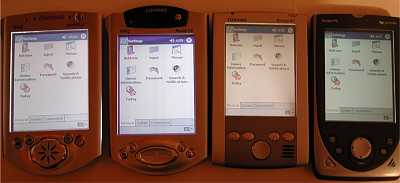 From left to right: Compaq iPAQ 3670, Compaq iPAQ 3835/3850, Toshiba e570, HP 565
|
| The cradle that comes with the Toshiba has a nice heft to it, and like the Casio’s it takes a little bit of practice to perfect the art of removing your PDA with one hand. Since I am right handed, I place the tip of my right ring finger on the cradle’s base, and push down as I use my thumb and pointer to grasp the e570 and pull it up and out. The cradle has a great weight, but unfortunately it |
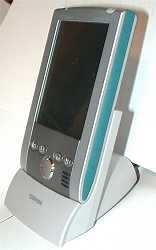 |
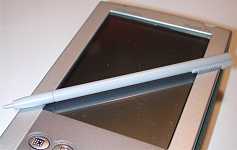 |
As usual, the stock stylus included with the e570 is the Yes,
|
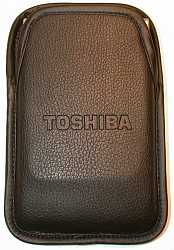 |
Just like you’ll find with the Casio and the iPAQ 3600 series, Toshiba has included a cheesy slipcover. Although it is described as leather in the accompanying literature, I can tell you that it doesn’t smell or feel like any leather I have ever purchased on purpose. My guess is that a lot of "naugas" were relived of their "hydes" to make these. ;0) I have to admit that I have done a 180º turn
I’m with you! The less bulk the |
So what’s the verdict on the Toshiba e570 regarding hardware? I like it!
I like the layout of the buttons, the clarity of the speaker, the size of the
unit, and the fact that it packs two expansion slots in such an elegant manner.
Did it replace my Casio? You bet it did. The styling of the Toshiba is more "me"
and as a result the e570 is the device I will be packing.
I also like the Toshiba quite a bit. Right now, it’s my
main brain. The only thing I would want changed is a
brighter screen. Other than that, I’m very happy with the e570.
Software Specifications
When you first get your Toshiba e570, there are two things you need to do
before you load a single bit of software on the device. The first is to install
Microsoft’s
DRIVER UPDATE, which is a Pocket PC 2002 patch that will noticeably improve
speed and performance.
Next, you need to follow the instructions listed here to perform the
SD AND CF FIX. "What in the world?" I can just see you shaking your
head and wondering.
Here’s the deal: Like Compaq, Toshiba released a Pocket PC that listed cards
as "Storage Card" and "Storage Card2." YUCK! When I first realized this I was
ready to riot! Remembering all the grief I went through with my iPAQ, I was
almost tempted to blow the Toshiba off as my "Daily Driver" for this
transgression (yes, I can be that petty). Fortunately, I didn’t have to,
as some forward thinking individual discovered this registry change that makes
CF cards show up as CF cards, and SD cards as SD cards. YAY!
I applied this registry hack after Judie told me about
it, and was very happy!
With those two fixes out of the way, it’s time for a minor rant…Why
do these Pocket PC manufacturers short the consumer when it comes to the
software included on the CD? I mean, so what if it is for a corporate end
user?! I mean, how much trouble would it be to get together a CD that contained
some great business oriented freeware and shareware that was specifically
directed to corporate users? It makes sense to me, but I guess it doesn’t to the
powers that be.
Tell me about it! I think the Toshiba has the worst
bundle of any PPC so far! That’s because it does!
With that said, let’s jump right into the software portion of this review…
Pocket PC 2002 Software Included in ROM:
Pocket Outlook – This is your PIM (Personal
Information Manager) Suite of applications. You get Contacts, Calendar, Tasks,
Notes, and Inbox. All of these applications will sync directly to Outlook 2002
on your desktop PC. Inbox can now sync multiple folders!
Pocket Internet Explorer – Web browser.
Pocket Word – View and edit Word documents.
Pocket Excel – View and edit Excel documents.
Microsoft Reader 2.0 for Pocket PC – Read
electronic books.
Windows Media Player 8 for Pocket PC – Listen to
digital music and watch movies.
MSN Messenger – Instant Messaging client just like
the one on your desktop.

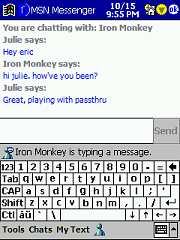
Microsoft Transcriber – Handwriting recognition
input method. This is now part of the ROM instead of an optional installation.
Block Recognizer – Graffiti clone input method.
If you have a Palm OS PDA and know Graffiti, then you’ll be right at home with
this input method.
This is my favorite input method. It helps keep me proficient in my
graffiti for when I am using my Palms. :0)
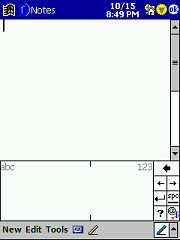
Terminal Services Client – With the terminal
services client a Pocket PC user can access Windows Terminal Servers and run
Windows applications. It only works with Windows Terminal Servers, which run on
NT 4 servers and Windows 2000. It does not work with 95, 98, or ME.
Spellchecker – A great new spellchecker
available for use in Word, and Inbox. Unfortunately, it’s not available in the
Notes application.
Voice Recorder, Calculator, Solitaire – We can’t forget your typical
voice recorder interface, a simple calculator and the solitaire game!
e570 Specific ROM Software:
Built in Storage – If you were looking for space in the Flash ROM
for extra storage, such as is available with the HP 560’s Safe Store, the iPAQ’s
File Store, or the Casio’s Built-in Storage, you will be sorely disappointed.
Once again, I am left wondering Why?? Perhaps this is yet another penalty
for being a corporate consumer. Not only do you not get any exciting software on
your setup disk, you also don’t get access to the extra 5-point-whatever-MB of RAM
that the PPC 2002 OS didn’t use…BIG CON in my book. Perhaps there is an
explanation for this, but I don’t see any special built-in Flash ROM
programs included with the e570 that would eat up this memory, so my guess is
that Toshiba just decided not to share it. BLAH!
It makes me mad that there might be some extra memory
available that’s just sitting there being wasted! I wonder if someone can write
an app to "unlock" it?
Oooooo – I hope so. Okay, I am issuing the challenge…unless someone knows
of a reason why it wouldn’t work?
Optional Software to Install:
The included setup CD the typical one that contains Outlook 2002, and Active Sync
3.5. It also contains the following:
Microsoft Money for Pocket PC – Works with Microsoft Money 2002 on
your desktop computer. Putting Money on your Pocket PC provides a convenient way
to keep up with expenses while you are out and about – then you can sync
everything when you get back home. I’ve been using this updated version for a
while now, and I am happy to report that it works way better than the 2000
version ever did – it also has a plug in for the today screen that simply
rocks! :0)
Microsoft Reader – This is the version everyone was waiting for –
solves the DRM problem, and allows you to download protected books from sites
such as Barnes
and Noble,
eFollet (excellent selection) and
Amazon (affiliate link). You can even listen to
Audible books from within Reader! You will
have to activate your Pocket PC to read the more current titles, but at least
you can use up to four devices with the same activation passport. Once you have
activated, there are several free titles you can download courtesy of Microsoft.
Hey – you can even load Reader to your computer, and it will read un-encrypted
books out loud to you!
Microsoft Pocket Streets – Portable maps for your Pocket PC.
AvantGo – Allows you to take personalized web content on the go, with
you, on your Pocket PC.
MSN Mobile – Hotmail service for inbox.
Microsoft pocket PC Games – Includes Hearts, Reversi and Minesweeper.
These games are actually already available (for free) from the Microsoft Pocket PC site.
Manuals – The entire Toshiba Hardware manual, in .pdf format, as
well as the e570’s Users Guide
Just as Casio did, Toshiba has completely under-whelmed me with their
lame software selection. Once again, if you don’t already own quite a bit
of Pocket PC ARM software (as I already did), you might be compelled to look
further into a different Pocket PC – such as the Compaq iPAQ or the HP 560. Yes,
regarding software, Toshiba dropped the ball…
Oh well, unless the manufactures would include full
versions of their software with the PPCs instead of just shareware versions,
it’s not that big of a deal. People can just go search for what the need. But I
do agree that it is disappointing not to include anything but stock Microsoft
apps.
Summary:
Poor CD software package and lack of "built in storage" file notwithstanding, I am very impressed with the Toshiba
e570. The hardware is notable due to its small size and sturdiness. Since the
Toshiba does have the benefit of at least running on an operating system with
which I have been relatively pleased, I can make up for software deficiencies by
adding my own. Some of the first programs I installed were Pocket Informant,
Loan Analyzer, and
Palm Reader.
During the e570’s evaluation period, I have begun to read new meaning into
the slightly crass one-liner that goes, "He may not be Mister Right, but he is
Mister Right Now." I mean, just because the PDA looks a certain way
and feels a certain way in hand, does that necessarily make it better? The reality
is, that with the relative uniformity that the different Pocket PC devices
feature – especially between the E-200 and the e570 – it really does just seem to
come down to what style PDA you prefer.
That’s right. Now that all the PPCs use the same
processor and for the most part all have the same features, it’s the one that
looks and feels the best to you that you should buy.
Price: $569
Pros:
Dual expansion ports built into very little more space and weight than a
single slot Pocket PC
Very solid and compact Pocket PC
65,000+ color screen is viewable outside
Cons:
No built-in file share as with other PPC 2002 devices
Anemic collection of software included on CD
Included slipcase is cheesy
SD/CF cover is poor fitting and cheesy
INIU Mini Portable Charger, Small 45W PD Power Bank, 10000mAh USB C in&Out Fast Charging Pocket Size Battery Pack, Travel Essentials Powerbank for iPhone 17 16 15 14 Pro Air, Xiaomi, Samsung S24 etc
32% OffANDERY Car Phone Holder for Magsafe [78+LBS Strongest Suction & 2400gf Magnetic] 360° Adjustable Car Phone Mount, Phone Holders for Your Car for iPhone 17 Pro Max 16 15 14 13 12 Air Plus, Carbon Fiber
40% OffProduct Information
| Price: | 569.0 |
| Manufacturer: | Toshiba |
| Pros: |
|
| Cons: |
|

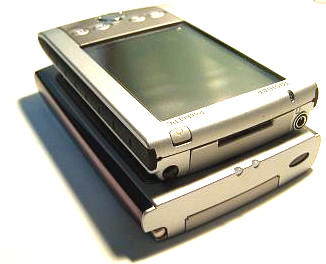
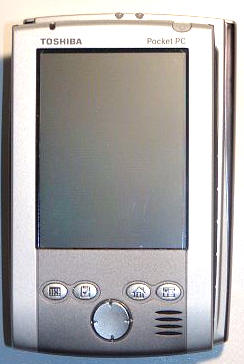
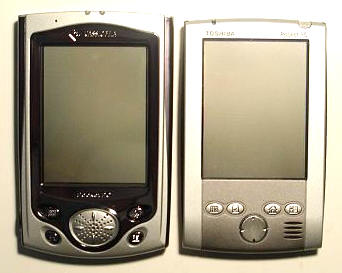
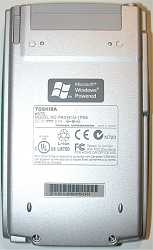
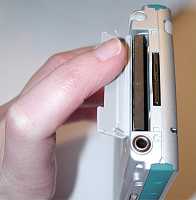
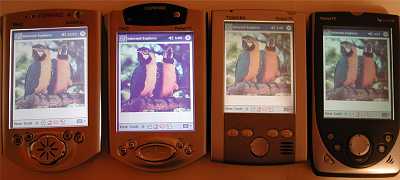


Gadgeteer Comment Policy - Please read before commenting
The 5555 is a excellent update on the same PPC. It does look like you MAY be getting tired of the old iPaq format so a few suggestions:
HP iPaq 2215
a Dell Axim
HP 1940
or if your not in a hurry
that JVC PPC.
Stay AWAY from the e755. It’s a great form factor and a nice device, but since they have abandoned year old devices (the e740) that had a ton of bugs that are still unresolved (well, ok, the latest PPC2002 ROM image fixes most of them) and they IGNORED the fact that e740 users would have paid them MONEY to get these units updated and even before 2003 was out, the support they provided was, shal we say lacking? Anyway, the 5555’s WiFi is flawless and works verywell for me combined with a CF + sleeve. I get around 4 hours of use with the WiFi on with this combo and a ton of hours with it off. When only used sparely, I can go two days on one charge. My only beefs:
DAMN Expanded Battery error messages…..just tell me right before you turn it off. The damn messages pop up when you least expect them and well before the extended battery is dead.
The 5555 seems to use the internal and expanded battery at the same time so when the extended is dead I have about 60-70 percent of the internal left. Not the arrangement I would like but I would rather see it rely on the External battery and then use the internal. The CF+ sleeve seems even thinner then the regular CF sleeve which is a bonus.
Thanks for the suggestions. 🙂 I love the form factor of the 1900, so I may have to seriously look at something in that line.
Judie :0)
You’ll definitely want to try out the 19XX before buying one… you probably already have. I am also an avid book reader and I found the 5-way button to be very stiff. It was uncomfortable to “page down” for long periods of time. The button can actually make your thumb sore on the unit I purchased. I returned it and bought a Tungsten instead. I seem to remember the 5-way feeling really cheap and it had a sort of a sharp rim around the button. Anyway, you might like it more than I did, but try it out for sure.
I have a Tungsten and an iPAQ 3950. I don’t see any compelling reason to upgrade to any of the models coming out. Mine has a long battery life, 64MB or RAM and so on and so forth. I personally don’t see what makes a 2200 series, for example, $300 better than the one I already have IMO. Things don’t seem to be changing a lot right now as far as I can tell. At least not enough to warrant a $300 to $500 cash outlay. Sure there’s the 2003 OS, but I won’t need a whole new unit to get that. Then again, that’s just my opinion.
Actually, other than seeing a 1900, I have never really played with one; Julie did that review.
If the joy-pad is stiff for up/down motions, then that will most likely nix it for me. eBook reading is my biggest PDA Ownership joy.
Judie :0)